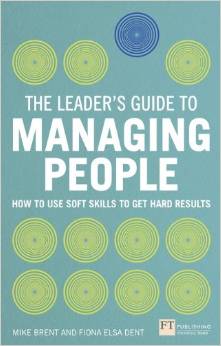HRZone has a range of books available for review. If you would like to receive one of our business books, free of charge, please contact the editor on editor at hrzone dot com and we can send you a list of what’s available. In return, we ask for a 400-700 word review of the book, its content and whether it’s appropriate for a senior HR director audience and for business professionals looking to become more effective in their roles.
Title: The Leader’s Guide to Managing People: How to Use Soft Skills to Get Hard Results
Authors: Mike Brent & Fiona Dent
ISBN: 978-0273779452

This book was reviewed by David Evans of Burn Bridge Associates.
Introduced by a quote from Jack Welch (“Before you are a leader, success is all about growing yourself. When you become a leader, success is all about growing others”), this is a valuable reference book for people in, or aspiring to be in, an organisational leadership role. Leaving aside the substantial debate about whether leadership is a ‘role’ or an attitude, the authors define and explain the leadership skills-portfolio comprehensively in this book.
Organised into three sections – the leader as an individual; leader-relationships; and organisational issues – the core of the book is about supporting leaders to act appropriately, adaptively and situationally. The first section covers issues relating to one’s reputation, career and personal resilience. These are helpful topics because they remind the reader what impact one can have on those around them and the importance of having a clear personal direction. I particularly liked the section on resilience since this is an under-rated leadership characteristic that perhaps merits greater coverage in the leadership literature: these authors do it justice with their ‘features of resilience’ model (p.34).This section has several practical frameworks for self-reflection: even if they are familiar to readers, they are nonetheless useful reminders of the value of assessing where we currently are in our working life.
Section two forms the lion’s share of the book. It covers the key topics of coaching, influencing, facilitating, team building, motivation, performance management, conflict management and relational intelligence. This subject-matter is helpful and succinct, and I found the discussion on motivation (chapter 9) fresh and thought-provoking. The chapter on relational intelligence – an interesting and valuable piece – is a well-summarised discourse on emotional intelligence and self-awareness. It deals with organisational politics and cultural diversity from the perspective of the leader and highlights a potentially-challenging element of the leader-role not always given the prominence it deserves.
The third section is perhaps the most interesting since it deals with the leader’s role in change and the most productive leadership behaviours. It also takes on the substantial challenge of discussing derailment. One’s propensity to be knocked off course as a leader is a defining characteristic, since it is what one does when things are not going to plan that marks one out as a leader. Like Hogan’s Dark Side and some other assessment tools, there are ways of identifying what individuals might do in unfamiliar, personally-hostile or stressful situations. Emphasising the point that leadership strengths can become limiting factors when circumstances are challenging is valuable and is well handled by the authors. Although the role of leader during organisational change has probably been ‘done to death’, these other two third-section topics deserve more space and consideration than the authors have given here.
The authors – both of whom have a history of working at Ashridge Management Centre, and hence have had access to an extensive research resource – subtitled this book “How to use soft skills to get hard results”: ‘soft skills’ is not an appealing phrase, since people-skills are usually those that managers and leaders find the hardest. However, the book covers a lot of ground in a well-formatted publication full of diagrams and frameworks. It is essentially a reference book; and it works effectively in this capacity. Each chapter ends with a useful list of ‘tips for success’. I’m sure that readers inspired by this book will use it as a springboard into other resources that get deeper into topics of interest.
My main concern with this book is that it does not cover much new ground: as a reference book there is nothing wrong with this. I also feel that the authors missed the opportunity to develop issues not covered as well in other leadership publications and instead opted mainly for the safe topics of the second section. Notwithstanding this, HR professionals will find this a suitable book to pass to aspiring or newly-appointed manager-leaders for their introduction to core personal leadership skills.
Reviewer’s rating 3 out of 5






